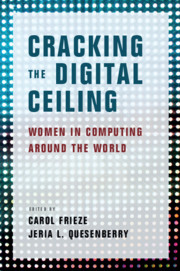Book contents
- Cracking the Digital Ceiling
- Cracking the Digital Ceiling
- Copyright page
- Contents
- Contributors
- Acknowledgments
- Introduction
- Part I Global Perspectives
- Part II Regional Perspectives
- Part III Cultural Perspectives from the United States and Europe
- Part IV Cultural Perspectives from Asia-Pacific
- 14 More Chinese Women Are Needed to Hold Up Half the Computing Sky
- 15 How the Perception of Young Malaysians toward Science and Mathematics Influences Their Decision to Study Computer Science
- 16 Women as Software Engineers in Indian Tamil Cinema
- 17 Women in Computing Education
- 18 Challenging Attitudes and Disrupting Stereotypes of Gender and Computing in Australia
- Conclusion
- Notes
- Index
- References
15 - How the Perception of Young Malaysians toward Science and Mathematics Influences Their Decision to Study Computer Science
from Part IV - Cultural Perspectives from Asia-Pacific
Published online by Cambridge University Press: 10 October 2019
- Cracking the Digital Ceiling
- Cracking the Digital Ceiling
- Copyright page
- Contents
- Contributors
- Acknowledgments
- Introduction
- Part I Global Perspectives
- Part II Regional Perspectives
- Part III Cultural Perspectives from the United States and Europe
- Part IV Cultural Perspectives from Asia-Pacific
- 14 More Chinese Women Are Needed to Hold Up Half the Computing Sky
- 15 How the Perception of Young Malaysians toward Science and Mathematics Influences Their Decision to Study Computer Science
- 16 Women as Software Engineers in Indian Tamil Cinema
- 17 Women in Computing Education
- 18 Challenging Attitudes and Disrupting Stereotypes of Gender and Computing in Australia
- Conclusion
- Notes
- Index
- References
Summary
It has been twelve years since our article “Women in Computer Science: No Shortage Here!” (Othman and Latih, 2006) was published. It is disheartening that after more than a decade, gender disparity in computer science (CS) is still an issue. Among important findings of our previous study is that young Malaysian females and males have a markedly different attitude toward science and mathematics compared with their Western counterparts. CS and information technology (IT) is not viewed as a masculine field by young Malaysians, which is a key reason why this nation does not encounter the problem of too few females being interested in pursuing a degree in CS/IT.
- Type
- Chapter
- Information
- Cracking the Digital CeilingWomen in Computing around the World, pp. 276 - 289Publisher: Cambridge University PressPrint publication year: 2019
References
- 3
- Cited by



